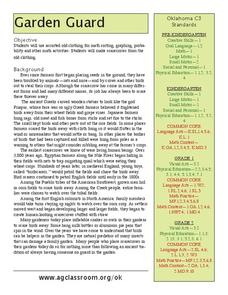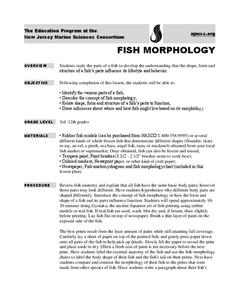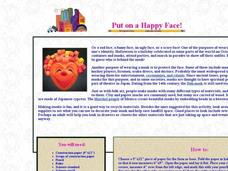Curated OER
Kirigami: The Ancient Art of Paper Cutting
Young scholars perform inquiry into the ancient art of Kirigami. The research provides a context for the activity and how it is related to History. Students also appreciate the art for the sake of its contribution to culture.
Curated OER
Garden Guard
Students read about the history of farming with the use of scarecrows and then sort clothing, build scarecrows, write descriptions, and more. For this scarecrows lesson plan, students also play a game called Garden Tag.
Curated OER
"For The Birds" [part II]
Students examine how Chinese and Japanese artists used different kinds of birds
as representations of ideas that were important in both cultures and create their own birds using the technique of origami.
Consortium for Ocean Science Exploration and Engagement (COSEE)
Fish Morphology
Life comes in all different shapes and sizes, and fish are no exception. Here, young scientists create fish prints as they learn how specific characteristics allow different species to survive in their particular habitats.
Gobal Oneness Project
Passionate Pursuits
Not all technology is digital. Teach learners about the low-tech maker movement with a photo essay about six artisans from California and two articles about the local creator movement. After tackling the photo essay in small...
Curated OER
Arthropod Mouth Parts and Food
Students identify the different types of mouths arthropods have for eating various types of food. Given photographs of the different types of arthropods, students identify which mouth they have and what type of food they can eat with...
Curated OER
What Causes Earthquakes?
In this earthquakes worksheet, learners will read information about how different myths and legends have been created to describe the cause of earthquakes. Students will use this information to complete 3 short answer questions.
Curated OER
Put on a Happy Face!
Students explore using recycled materials. In this ecology/art lesson, students use recycled materials to create a Halloween mask. Students view folk art made of natural and available resources, and discuss possible cultural uses for...


!["For The Birds" [part II] Lesson Plan "For The Birds" [part II] Lesson Plan](http://content.lessonplanet.com/resources/thumbnails/122476/large/cgrmlwnvbnzlcnqymdeymtaxny0yoda5lwu0ew85zi5qcgc.jpg?1414222640)




